ST PETER'S QUARTER TRAILS - ST PETER'S STREET
ST PETER’S QUARTER TRAIL 3
St Peter’s Quarter stylish and absorbing.
Looking up St Peter’s Street
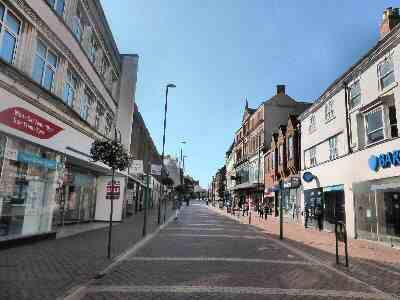
St. Peter’s Church in St Peter’s Street forms the core of an early part of the medieval expansion of Derby. The settlement developed along the historic north-to-south route, which connected St.Peter’s Street with Market Place, across St Peter’s Bridge over Markeaton Brook. The bridge disappeared in the 19th century when the brook was culverted. St Peter’s Church is the oldest in Derby and still contains some Saxon fabric. Precisely when St Peter’s was founded is uncertain, but it was recorded in the Domesday Book and may go back much further. According to current thinking, it was founded in 1042.
The tradition for Shrovetide Football started in the 18th century and in Derby, all able-bodied men living south of Markeaton Brook were named after the parish of ‘St. Peter’s, and those living north of it were called ‘All Saints’. Proceedings commenced outside the Guildhall when the ball was ‘Turned up’ on Shrove Tuesday each year and finished on Ash Wednesday. Shops and businesses were boarded up as the whole town was the pitch including the river and the brook. The objective was to score a goal either at Nun’s Mill or at an agreed point on Osmaston Road. The game was so brutal that several attempts to stop it were made before it was finally abolished. A French prisoner of war once said about the game, “If the English call this playing, it would be impossible to say what they call fighting.”
Former Midland Bank

The imposing building on the corner of St Peter’s Street and Albert Street was built in classical style, in 1910. The premises are now occupied by HSBC Bank, previously the Midland Bank. The narrow lane running alongside the building is Thorntree Lane, one of Derby’s cobbled medieval thoroughfares that still survive today. This would have been the width of many of the streets in the town before their widening in the 19th century.
Before the realignment of St Peter’s Street in the 1880s, Thorntree House stood on the bank site. It had been rebuilt for Joseph Strutt in the 1820s, the youngest son of Jedidiah Strutt and Elizabeth Woollett. The Strutt family made a fortune from their mills in Belper, Milford and Derby. All three Strutt brothers were radical social reformers who made significant donations and founded several important institutions in the Derby Area. Joseph opened up his house and gardens to the general public as an art gallery and museum, the first in the town, to enable citizens of all classes to cultivate an appreciation of works of art. His collection also included an example of an Egyptian Mummy that now rests in the Derby Museum. He also donated the Arboretum to the people of Derby.
Former Boots Building

The Old Boots Building now the home of Costa Coffee was formerly occupied by Boots the Chemists. The Halifax Building Society took over ownership in 1975 before it became a coffee shop. It is an Arts-and-Crafts designed building by Albert Bromley and is one of the city’s most appealing buildings. What particularly draws attention are the four small statues in niches spaced out above the shop frontage. The statues are of Florence Nightingale, the ‘Lady of the Lamp’, John Lombe a member of the family who established the Silk Mill, William Hutton who published a ‘History of Derby’ in 1791 and Jedediah Strutt, the first of a family of mill owner’s and public benefactors. Boots moved from its old site to a new one on the corner of St Peter’s Street and East Street in 1912.
John Boot, born in Radcliffe on Trent, Nottinghamshire in 1815, founded Boots the Chemists 34 years later. It was his son, Jesse Boot, who transformed the company into a national retailer. The company branded itself as ‘Chemists to the Nation’ before Boot sold out his controlling interest to American investors in 1920. However, deteriorating economic circumstances in North America saw Boots sold back into British hands in 1933. In 2005, Boots and Alliance UniChem merged, the merger becoming effective on 31 July 2006. A further merger with company giant Walgreens took effect at the end of 2014.
East Street
East Street was formerly known as Bag Lane and was an important route, which connected the space in front of St Peter’s Church with the Cock Pitt. The street has now been pedestrianised and in the centre sits the statue of the Derby Ram, between Albion Street and Exchange Street, where the Co-Op used to take up most of the space.
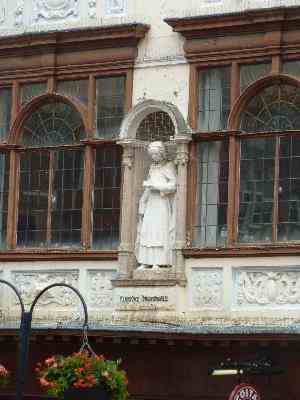
On the southern corner of St Peter’s and East Street was the home to Boots the Chemists from 1912 to 1975, still one of the most admired buildings in Derby. On the opposite side of the road was The Midland Drapery. It had a distinctive magnet symbol at the parapet level on the street corner. Founded by Edwin T. Ann, who later became an Alderman, it was one of the largest department stores in the country, employing 300 people in 1909. The store closed in 1970, the same year that the town lost Thurman and Malin and Barlow and Taylor, two other very well-known and respected department stores.
Sir George Clarke Simpson Blue Plaque
In 1910, George Clarke Simpson was a meteorologist for Robert Falcon Scott’s famous Antarctic Terra Nova Expedition. Given the nickname ‘Sunny Jim’ by the other expedition members, he constructed one of the continent’s first weather stations, carrying out balloon experiments to test the atmosphere and determine how altitude affects temperature. He was in command of the station for several months when Scott and his party left for their ill-fated journey to the South Pole in November 1911. Scott and members of his party died the following year, 150 miles away from base camp, of cold and exhaustion, but Sir George was able to return home.
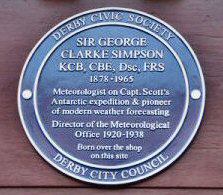
He went on to become an important pioneer of meteorology at the University, serving as Director of the HM Meteorological Office 1920-1938 and President of the British Meteorological Society 1940-42. His work involved research in lightning, devising the Simpson wind force scale (Beaufort Scale) and experiments on altitude affecting temperatures. Born at 44 East Street, on September 2, 1878, he spent his early years in Derby. He was a pioneer of the modern science of meteorology and was honoured with a Knighthood for his services in 1935. He died in January 1965.
Former Co-op Building
Founded in 1849, the Co-op in Derby was one of the first cooperative societies in the World. For nearly all of the 1990s the Co-op occupied most of Albion Street/Exchange Street and the society’s main department store remained on Albion Street until April 2013. The Co-op offered a wide range of services and at the beginning of the last century, there were 60 separate stores and departments in Derby. Customers were particularly attracted by the payment of ‘divi’, where shoppers received a share of the profits. The more they spent the greater the reward. The building on the corner of East Street and Exchange Street was acquired by Lee Longlands.
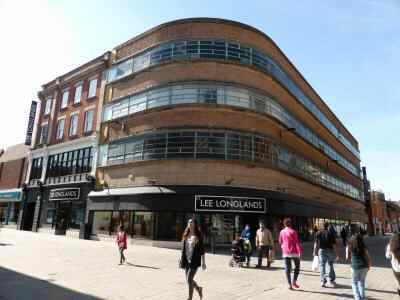
Derby Ram Statue
The statue was created in 1994 by sculptor Michael Pegler. It is an eight-foot-high sculpture in Derbyshire gritstone, erected at the corner of Albion Street and East Street, following the completion of pedestrianisation in the city centre. A ballad was written many years ago about the ‘Derby Ram’ who by tradition was huge and much larger than depicted by the sculptor.
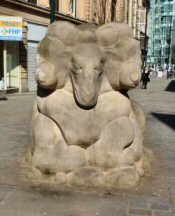
Derby County Football Club is known as the ‘Rams’ and the name has been used by several other organisations. The ram has played an important role in Derby Regimental history since 1858 when it first became a mascot. According to military history, the commanding officer of the regiment saw a fine fighting ram tethered in an Indian temple yard. He instructed one of his men to acquire the ram, which was the beginning of a long, illustrious career for the animal. It was named Private Derby and marched 3,000 miles throughout central India, and was present in six actions. As a result, he was awarded the ‘India Medal with Clasp Central India’. In all, Private Derby fought in 33 battles without once being defeated. Since then, there has been an uninterrupted run of rams acting as Regimental mascots all called Private Derby and numbered in sequence. This changed when Private Derby who joined the Regiment in 2015, was given the rank of Lance Corporal and the entitlement to wear a single stripe on his rank slide.
Old Grammar School
It is not known when Derby School was founded, or who founded it, but the first mention is in a charter of Darley Abbey when the canons went to their newly founded Augustinian Monastery in 1146. Shortly after the dissolution of the monasteries, a charter was passed in 1554, for a free grammar school to be built in Derby. As a consequence, the Tudor building in St Peter’s Churchyard was erected and used as a school for three centuries. During these years, it became one of the most successful smaller public schools in the country. Afterwards, it served a variety of purposes, it was in the ownership of the local entrepreneur, Richard Felix, for thirteen years, and operated as a Heritage Centre. Felix did much to put Derby on the tourist map, particularly as a result of introducing ‘Ghost Walks’ and for his involvement with television. He played a leading role in the popular TV series, ‘Most Haunted’ for several years. The Heritage Centre closed in October 2005 and the premises are now occupied by a hairdresser.
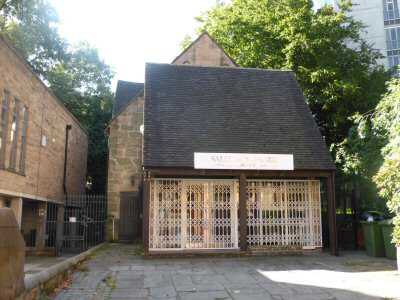
St Peter’s Churchyard
Business confidence was high in the town towards the end of the 19th century and St Peter’s Street and St Peter’s Churchyard saw significant redevelopment. In the 1860s successful negotiations took place between the council and St Peter’s Church for the purchase of a strip of land to enable the street to be widened, for which the church was paid £130. The council also erected a wall at the front of the church which remains.
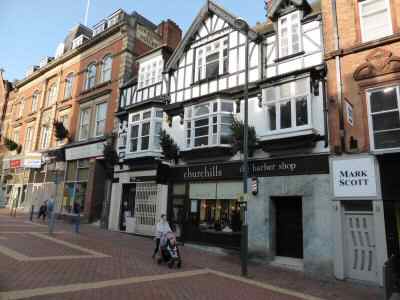
The church was not so fortunate in the 1880s when St Peter’s Churchyard was widened when another piece of the churchyard land was taken and the old Liversage Cottages were demolished. As it was reported that despite skeletons being exposed and cartloads of soil and rubbish excavated from the street being tipped over the graves no compensation was paid.
After the completion of the redevelopment, the whole of the north side of St. Peter’s Churchyard was turned over to commercial use. The buildings were purpose-built and well-designed by skilled architects with plenty of attention to detail. As a result of the road widening the buildings were not very deep, but this was compensated for by creating tall structures of three or more floors. During the latter part of the 19th century, the upper floors of the buildings were often used as part of the shop floor. Both Boots (before their move to the other side of St Peter’s Street) and Thurman and Malin did not rely solely on the ground floor for selling space.
The principal public building was the County Court which was of greater depth than its neighbours. Gothic Revival in construction with alternating bands of dark pink brick and buff-coloured moulded terracotta. It is now known as the Old Courthouse and is Grade II listed and divided into several business units. Further along the street on the opposite side is a former chapel built in 1816 for the Methodists, but sold to the Wesleyans five years later when the chapel ran out of money. It was nicknamed Marrowbones Chapel as three butchers were the main benefactors. Having served its time as a Derby County Football shop, it is now the home of Rathbones, a voluntary UK-wide youth sector organisation.
St Peter’s Church
St Peter’s Church, the jewel in the crown of the Quarter is the oldest in Derby and still contains some Saxon fabric. Precisely when St Peter’s was founded is uncertain, but it was recorded in the Domesday Book and may go back much further. On the pillar at the north side of the chancel arch, and on the wall of the south aisle, are capital letters carved by Norman craftsmen. Much of the church dates back to medieval times, the arches, and between the central and side aisles, together with the windows in the south and north walls, all relate to that period. An ancient carved stone in the south wall is claimed to be an old Saxon cross that used to stand in the old churchyard. The squint does not have anything to do with lepers as may have been first thought but was used by the clergy to see the high altar from the first-floor vestry. The Flemish chest, which stands in the south aisle, is reputedly a product of the 14th century.

The church celebrates its birthday every year on St Peter’s Day and according to present-day church thinking, it was founded in 1042. In 1349, St Peter’s Parish was badly hit by the Black Death, and victims were buried vertically in the churchyard to save space. Both the vicar of St. Peter’s and his chaplain of the Blessed Virgin were among those who lost their lives to the Black Death. Over 200 years later during a further outbreak of the plague, St Peter’s Parish once again was severely hit. As a consequence, the churchyard could no longer handle all the burials, and some were diverted for internment at Boulton Chapel.
Rich parishioners, Robert Liversage and his wife who died childlessly left a will intended to benefit St Peter’s Parish. In the will, provision was made for a chapel to be built at the east end of the north aisle. It was also arranged in the early 1530s that thirteen poor people should attend divine worship in the chapel every Friday and receive a silver shilling. There was never any difficulty in attracting the required numbers; in fact, the reverse was the case. The problem was in stopping the fights that broke out over who was to receive a silver shilling.
Fortunately, the majority of the Liversage bequest was carefully managed and grew considerably in value and when the old Liversage Cottages in St Peter’s Churchyard were demolished they were replaced with the Liversage Almshouses on London Road, which still house pensioners from St Peter’s Parish to this day.
In 2010, St Peter’s Church raised the required money to re-house the Florence Nightingale window from the chapel at the old Derbyshire Royal Infirmary. This move became necessary as the hospital combined with the former Derby City General Hospital at Mickleover, now the Royal Derby Hospital, making the chapel surplus to requirements. The newly installed widow has attracted a substantial number of visitors to the church.
